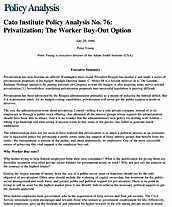Privatization has now become an official Washington buzz-word. President Reagan has lauded it and made a series of privatization proposals in his budget. Budget Director James C. Miller III is a fervent believer in it. The Gramm-Rudman-Hollings initiative, by putting pressure on Congress to trim the budget, is also inspiring some moves toward privatization.[1] Nevertheless, translating privatization proposals into successful legislation is proving difficult.
Privatization has been advocated by the Reagan administration primarily as a means of reducing the federal deficit. But if it is promoted solely for its budget-cutting capabilities, privatization will never get the public support it needs or deserves.
The way the administration went about privatizing Conrail–selling it to a sole private company instead of to its employees or through a public stock offering–has alienated all the interest groups whose support the administration should have been able to attract. And it is no wonder that the administration’s new policy for dealing with Amtrak–letting it go bankrupt and then seeing if anyone wants to buy some of the pieces–has failed to generate much enthusiasm.
The administration does not yet seem to have realized that privatization is as much a political process as an economic one A successful policy for privatizing a public entity seeks the support of those interest groups that benefit from the entity–the management, a portion of the public, and, most importantly, its employees. One of the most successful means of achieving this vital support is the employee buy-out.
About the Author

This work is licensed under a Creative Commons Attribution-NonCommercial-ShareAlike 4.0 International License.
